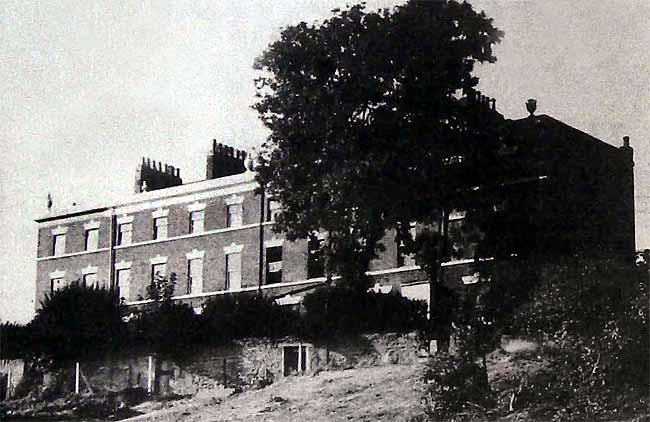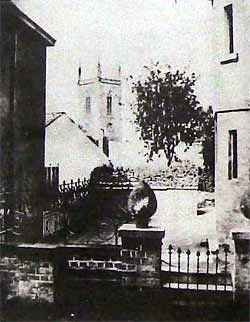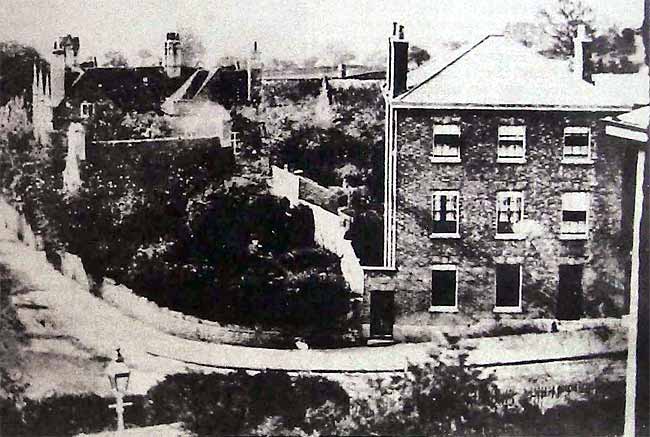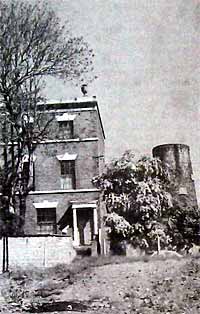< Previous
'A SUPERIOR COUNTRY RESIDENCE':
The story of Belvoir Terrace
By Stephen Best
 BELVOIR TERRACE, 1978. Copied from a transparency by Dave Ablitt.
BELVOIR TERRACE, 1978. Copied from a transparency by Dave Ablitt.Over the years Sneinton has lost a number of interesting and historic buildings. Around the turn of the century Sneinton Manor and the Hermitage houses were demolished, and between the wars the Victorian church of St. Luke disappeared. Recent years have seen the dismantling of St. Philip's church, and of the fine late Georgian houses in Notintone Place.
The latest major loss in Sneinton, and, it must be hoped, the last one, was the destruction in the late 1970's of Belvoir Terrace. Estimates varied as to the age of these six splendid houses, which stood back above Dale Street just where the children's adventure playground now is. The City of Nottingham's register of listed buildings described them as late 18th century, while the Nottinghamshire volume in Pevsner's 'Buildings of England' series considered that they were built about 1820. In fact the story begins on May 30th, 1834, when the Nottingham Journal carried this advertisement.
'GENTEEL RESIDENCES, BELVOIR TERRACE, SNEINTON, TO BE LET And entered upon at Midsummer next, or when completed. Several newly-erected and convenient DWELLING HOUSES, situate at Old Sneinton, near the Church, each comprising Low Kitchen and Cellars: on the Ground Floor, Dining and Breakfast Rooms, and Scullery, with Laundry; Drawing Room and three Bed Rooms, on the first and second stories, with Store Room, & c. Each house has a separate yard, garden & c. and is well supplied with hard and soft water.
The soft water is conveyed into the kitchens. In point of situation, for salubrity and magnificence of prospect, the above Dwellings are unrivalled, with which is combined the convenience of a distance of only about ten minutes walk from Nottingham Market Place. Rent and Payments Moderate.
For further particulars, apply upon the premises; or to J. E. Hall, Stone and Marble Mason, Hockley, and Canal Street, Nottingham.'
The advertisement contains several features of interest. Clearly the owner was aiming at the upper end of the house market, stressing the advantages of the site, with its views into open country. The reference to the convenient access to Nottingham Market Place suggests that the advert was placed with business men in mind, and fit business men at that, if they were expected to walk in to the centre of Nottingham in only ten minutes. It is worthy of note that the Belvoir Terrace houses were not offered for sale, but were to let.
Two months later, on July 18th, 1834, the newspaper included a short news item on the Terrace. 'The newly and substantially-built mansions in this truly delightful situation, are again advertised to be let. We feel great confidence in recommending them to the notice of every person who wishes to occupy a superior country residence, with all the advantages which a contiguity to a populous market town affords. The scenery from the terrace is of the most picturesque and diversified character.' Elsewhere in the same issue of the Nottingham Journal there appeared a second advertisement for Belvoir Terrace.
This one omits the detailed description of the houses, choosing rather to emphasise the select nature of the Terrace, and of its hoped-for tenants.
'To be LET, with immediate possession. BELVOIR TERRACE, OLD SNEINTON. Having previously given notice, by Advertisement, that the above-named DWELLINGS, which are situated within ten minutes walk from Nottingham Market Place, were nearly finished, the Proprietor respectfully announces to the Gentry of this neighbourhood, that they are now completed. As no expense has been spared to render them suitable for Families of the highest respectability, the Proprietor solicits their inspection of the same, being fully assured they will not be disappointed. The Terrace is delightfully situated, having a southern aspect, commanding a very extensive and admirable view from East to West; and the houses are replete with every convenience that will tend to promote domestic comfort. For further particulars apply on the premises; or to J. E. HALL, Stone and Marble Mason, Hockley, or Canal Street, Nottingham. N.B. Any Gentleman wishing to have a Carriage House, may be accommodated.'
Prospective tenants were doubtless pleased to note that although the walking time from the Market Place had now shrunk to within ten minutes, those who were unable to keep up with this punishing schedule would be able to maintain their own conveyance on the premises. Belvoir Terrace in the 1830's must indeed have lived up to its name, 'beautiful view', and the prospect to the south and south-east over the fields to the Trent and beyond can only have been superb, with Belvoir Castle itself in the far distance.
The name of J. E. Hall appears in both of these advertisements, and introduces a man who was in business in Nottingham for some forty years. James Ebrank Hall is described in local directories variously as a stone and marble mason, builder and carpenter, contractor, and builder and stonemason. His yard was in Cowslip Court, Hockley, and his house on Canal Street. About 1850 he moved his business premises to Carrington Street Bridge, and made his home, most interestingly, at Belvoir Terrace, before moving at the beginning of the 1860's to Colwick Road. Whether J. E. Hall was the 'proprietor' referred to in the news item, as well as being the builder of Belvoir Terrace, is uncertain.
What, though, of the other occupants of Belvoir Terrace, the 'families of the highest respectability' who took these 'genteel residences'? Here the main sources of information are the Nottingham directories and the census enumerators' returns. It is not always easy to sort out the identity of the residents, as compilers of directories and census officials alike were less than precise in their use of 'Belvoir Terrace' as an address, but most occupants can be named with certainty, and a comfortable, if not opulent way of life becomes apparent.
In 1851, as we already know, J. E. Hall, builder, was living at Belvoir Terrace. His family comprised his wife and six children between the ages of 6 and 19. Living with them was a girl of 17, described as a 'house servant'. Another resident was Samuel Weston Moore, a Nottingham town councillor and a lace manufacturer, of Hockley Mill. Mr. and Mrs. Moore also had six children and one living-in servant. A third household in 1851 was that of Richard Hopcroft, a 'lace manufacturer employing 8 males and 410 females’ at his firm on High Pavement.
By the time of the 1861 census the Hopcrofts had two infant children, and to look after this family they employed a resident staff of three, two house- servants and a monthly nurse. George Alfred Sharp, a silk throwster of Cantello and Sharp, Newark Street, had also taken a house on Belvoir Terrace with his wife and three children.
They too, had servants, a housemaid and a 13 year old nurse maid. The most interesting newcomer since 1851, though, was the occupant of No. 1 Belvoir Terrace, John Webster, who had gone to live there about 1853. We must give Mr. Webster more than a passing glance. He was a lace dyer and dresser of Dakeyne Street.
Mr. and Mrs. Webster had seven children; the eldest son, resoundingly named Robert Dakeyne Webster, was a hosier, and the other two boys were in the lace trade. The three elder Webster daughters, aged between 19 and 23, had no occupation, so it may be conjectured that they occupied themselves in good works, or helped the servant to keep their big house in order. John Webster was a churchwarden and played the flute in the Sneinton church band, besides forming a company of the Robin Hood Rifles.

BELVOIR HILL and SNEINTON CHURCH (Courtesy the National Library of Wales)
He was a notable enough figure in local public life to have been remembered in the Weekly Guardian in January 1931 as 'the uncrowned King of Sneinton.' It may be, though, that the Sneinton local historian owes John Webster an especially warm vote of thanks. A series of extraordinarily interesting photographs of Old Sneinton was taken some time before the end of February 1860 (the date cannot be after this, as Sneinton church sports its four pinnacles in these photographs, and two of these were blown down in a prolonged and severe gale which lasted from the 26th to the 28th of that month). Some of the photos were clearly taken from Belvoir Terrace, and at least one could only have been set up from the side windows of number one. About this time the short-lived Nottingham Photographic Society was formed, and in January 1859 staged an exhibition at the Exchange Rooms in Nottingham.
Reviewing this show, the Photographic News of January 21st, 1859 had this to say. 'It is exceedingly gratifying to know that many gentlemen of this town and neighbourhood are taking a practical interest in photography, and often a leisure hour is employed by them in this fascinating art, in spite of finger stains, the smell of acetic acid & c.&c. The productions of Mr. Henry Taylor, Mr. Felkin, Mr. Webster . . . . . . fully prove that such occasional employment of time must lead the mind to appreciate the beautiful in nature and assist in the diffusion of correct taste in art. ' in view of this it is interesting to discover that photographs of 1 Belvoir Terrace at the end of its days show a large expanse of greenhouse-like glazed wall at the back of the top floor, consistent with the conditions required for photographic printing as it was done in the 1850s. Although this is, perhaps, not absolutely conclusive evidence that he took these early photographs, we may perhaps be forgiven for saluting Mr. Webster respectfully as he passes into history. He was, though, very much in evidence at Belvoir Terrace until the 1890s. Another notable figure resident in the Terrace for a short while in the 1860s was the Rev. Allen Mines of the Albion Chapel. Mr. Mines was a celebrated preacher much in demand throughout the area for his oratory at anniversary services.
 DALE STREET and SNEINTON HOLLOWS FROM BELVOIR TERRACE
DALE STREET and SNEINTON HOLLOWS FROM BELVOIR TERRACE Sneinton Manor is in the background. (Courtesy the National Library of Wales)
By 1871 the social stability of Belvoir Terrace, as reflected in the census, seems to have suffered not at all. Mr. Webster's sons Robert Dakeyne and Arthur rejoiced in the occupations of 'retired hosier' and 'retired lace dresser' at the ages of 34 and 29 respectively. Mr. John Bowyer Gough, who had lived there at least since 1853, had retired from his post as secretary to the Ambergate Railway Company (later the Nottingham & Grantham Railway & Canal Co., and later still the Great Northern Railway). Mr. Gough had left his office at the London Road Station, where his son now worked in his stead, and in 1871 described himself as 'gentleman'. Newcomers included two more families of the Hopcroft clan. Of these Henry Hopcroft, a hosier, and his wife had no children, but nonetheless employed a resident domestic servant and a washerwoman to attend to their needs. Another recent arrival was Charles Mulholland, lace dresser, of Mulholland & Wright, Walker Street and Dakeyne Street, Sneinton.
It may be mentioned in passing that although, of the residents of Belvoir Terrace, John Webster at 65 considered himself a 'retired lace dresser' and a Mr. George Wakerley at only 50 was a 'retired silk manufacturer', Mr. William Tomlin who lived a few houses away on Belvoir Hill had no time for such gentility. With lip- smacking relish he gave his occupation at the age of 82 as 'houses, dividends, interest money.' Mrs. Tomlin was listed as 'proprietor's wife', and their heir Alfred as 'son and land- owner.' The Tomlins were a colourful family, related to George Green, but theirs is another story.
In the 1870s another clergyman was briefly resident at Belvoir Terrace. This was the Rev. Isaac Raine, curate of St. Luke's church, Carlton Road. (St. Lukes was pulled down in 1925, but its church hall survives as the premises of the Tennant Rubber Co. Ltd.)
1881 is the latest year for which the census details of the Belvoir Terrace households are available. The Webster family had suffered the loss of Mrs. Webster and three of the children had left home. Robert, the eldest son who had been 'retired' ten years previously was now a book keeper, while two of the grown-up daughters gave their occupations as 'domestic duty' and 'no occupation'. For the first time no Hopcrofts were resident at the Terrace, but two more pillars of the lace trade had moved in; Mr. William Carter, a retired lace manufacturer, and Mr. A. J. Cooper of J. Cooper & Son, Station Street. A new profession was represented by James Edwin Truman, 'architect employing 2 clerks' of Truman and Pratt, Cauldon Place, 37½ Long Row. The Trumans had two young children, and employed a nurse maid and a general servant to attend to the family's needs. At No. 4 Belvoir Terrace was the household of John Keating, accountant at the Midland Railway Station, Derby. Mr. and Mrs. Keating had eight children ranging in age from 11 to 27, but (a sign of the times perhaps?) had no living-in servant. Their 23 year old daughter Mary was, however, described as being engaged in 'house duty'. Two of her sisters were to be prominent in the educational life of Nottingham for many years. Catherine Frances Keating, who was 21 in 1881 and a governess, ran one of the earliest kindergarten schools in the town, at Carrington.
She eventually moved to Mountford House School at Sherwood, retiring in 1927 to yield the position of headmistress to her sister Emma, a schoolgirl of 14 in 1881. Emma Keating died at Caythorpe in 1954 aged 87, one of the last links with the Belvoir Terrace of Victorian days.
Of the twenty-two household returns collected at Belvoir Terrace from the censuses of 1851 to 1881, nineteen listed resident servants, a reflection of the comfortable middle-class lives lived there. It is not possible to be certain of the date when the Terrace ceased to be a centre of fashionable Sneinton; until the turn of the century heads of reputable Nottingham businesses continued to move in there, such as Harry Alfred Lloyd of Lloyd & Cowley, fancy drapers of Pelham Street, and Harry Barratt, box manufacturer, of Broad Street. It was, however, inevitable that with the continual encroachment of industrial Nottingham and the development of working class housing all round Sneinton, the families that could afford to moved out to quieter and more unspoiled places. Outside the town villages like Ruddington, East Leake, Radcliffe-on-Trent, Burton Joyce and Lowdham were easily accessible, and within Nottingham areas such as Mapperley Park offered more opportunities for a gracious way of life than did Sneinton. By 1905 the Webster house at 1 Belvoir Terrace had become 'Misses Helen and Emily Webster, apartments', and in 1910 the residents included a postal clerk and a fishmonger; estimable occupations both, but unlikely to have been represented on Belvoir Terrace in its heyday.
 THE TERRACE AWAITS EXTINCTION, THE MILL, RE-BIRTH . . . .
THE TERRACE AWAITS EXTINCTION, THE MILL, RE-BIRTH . . . .Few people can be left who remember the full splendour of the Terrace, and it is ironic that it came into the limelight most fully this century when its very existence was threatened. Nottingham City Council listed Belvoir Terrace as of special architectural interest, giving it, in the process, perhaps the fullest description we have. 'Good group of . . . . . . houses in red brick. Stucco bands at sills. 2 windows to each house with rusticated stucco lintels. Moulded stone cornice surmounted by 5 urns. Projecting rectangular Tuscan porches'. This was to be the Terrace's epitaph; even with the supposed protection that listing gave, it was too late. The architectural merits of Belvoir Terrace could not make up for the fact that, by the late 1970s, the houses were not fit to live in. By 1978 they were gone, and where the gentry of Sneinton once enjoyed the view from the Terrace, visitors to the windmill now look out admiringly towards the Trent, and the children of Sneinton play.
My thanks to Pauline Heathcote and Dave Ablitt for help and information, and to the National Library of Wales for permission to reproduce the early photographs of Sneinton.
< Previous
